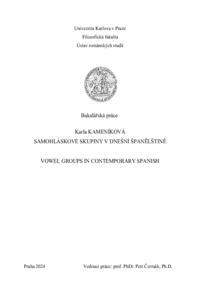Samohláskové skupiny v dnešní španělštině
Vowel groups in contemporary Spanish
bachelor thesis (DEFENDED)

View/
Permanent link
http://hdl.handle.net/20.500.11956/192143Identifiers
Study Information System: 261038
Collections
- Kvalifikační práce [23976]
Author
Advisor
Referee
Rubešová, Štěpánka
Faculty / Institute
Faculty of Arts
Discipline
Hispanian Studies
Department
Institute of Romance Studies
Date of defense
17. 6. 2024
Publisher
Univerzita Karlova, Filozofická fakultaLanguage
Czech
Grade
Excellent
Keywords (Czech)
španělština|fonetika|osvojování jazyka|hiát|diftong|syneréze|synalefaKeywords (English)
Spanish|phonetics|language acquisition|hiatus|diphthong|syneresis|synalephaBakalářská práce Samohláskové skupiny v dnešní španělštině se zabývá problematikou výslovnosti diftongů a hiátů českými mluvčími španělštiny. Cílem práce je zjistit, jak jsou vokalické skupiny španělštiny vyslovovány českými mluvčími španělštiny a jakým způsobem se pokročilost na výslovnosti promítá. Skládá se ze dvou částí, teoretické a praktické. V první části autorka teoreticky popisuje vokalický systém češtiny a španělštiny, včetně samohláskových skupin, kde zmiňuje diftongy, hiáty a triftongy, přičemž se zaměřuje převážně na první dva zmíněné jevy. Dále uvádí, jaké mohou nastat výslovnostní změny a v neposlední řadě se zabývá historickým vývojem obou systému. Druhá část je zaměřená prakticky a vychází z analýzy zvukových nahrávek, kde je porovnáváno, v jaké míře se čeští studenti španělštiny přiblížili výslovnosti rodilých mluvčích a jaké faktory mají na jejich pokročilost vliv.
The bachelor thesis Vowel groups in contemporary Spanish is focused on the pronunciation of diphthongs and hiatuses by Czech speakers of Spanish. The aim of the thesis is to find out, how the vowel groups are pronounced by Czech speakers of Spanish and how the level of the language is reflected on the pronunciation. It consists of two parts, theoretical and practical. In the first part, the author of the text describes theoretically the vowel system of Czech and Spanish language, including the vowel groups, where she mentions diphthongs, hiatuses and triphthongs, focusing mainly on the first two mentioned phenomena. She also presents the changes that can occur in pronunciation and, last but not least, she characterizes evolution of both systems. The second part is practically oriented, and it is based on the analysis of audio recordings where it is compared the extent to which Czech students of Spanish have approached the pronunciation of native speakers and what factors influence their progress. Key words: Spanish, phonetics, language acquisition, hiatus, diphthong, syneresis, synalepha
